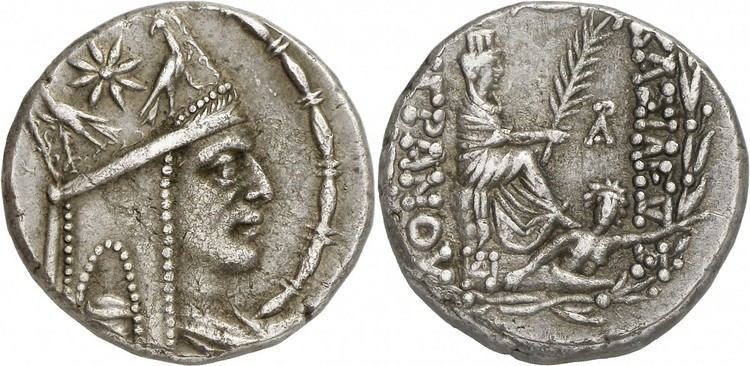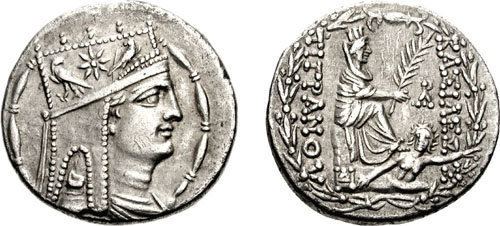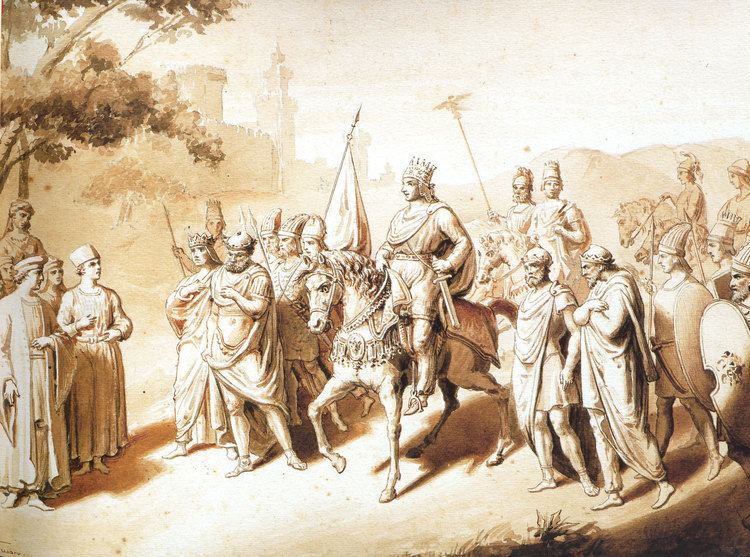Reign 95–55 B.C. Name Tigranes Great Role King | Died 55 BC | |
 | ||
Issue With Cleopatra, three sons: Zariadres, Artavasdes II, Tigranes & two daughters: one married Pacorus I of Parthia and the other married Mithridates I of Media Atropatene Children Artavasdes II of Armenia, Pacorus I Parents Artavasdes I of Armenia, Tigranes I Similar People | ||
Grandchildren Tigranes III, Artaxias II | ||
King of Kings: Tigran The Great. (Part 1)
Tigranes II, more commonly known as Tigranes the Great (Armenian: Տիգրան Մեծ, Tigran Mets; Ancient Greek: Τιγράνης ὁ Μέγας Tigránes ho Mégas; Latin: Tigranes Magnus) (140 – 55 BC) was King of Armenia under whom the country became, for a short time, the strongest state to Rome's east. He was a member of the Artaxiad Royal House. Under his reign, the Armenian kingdom expanded beyond its traditional boundaries, allowing Tigranes to claim the title Great King, and involving Armenia in many battles against opponents such as the Parthian and Seleucid empires, and the Roman Republic.
Contents
- King of Kings Tigran The Great Part 1
- Tigranes the great
- Early years
- Alliance with Pontus
- Wars against the Parthians and Seleucids
- Wars against Rome
- Pompey and the reconciliation with Rome
- Legacy
- Historical
- Modern
- References

Tigranes the great
Early years

Tigranes had been a hostage until the age of 45 at the court of King Mithridates II of Parthia after the Armenian defeat in 105 BC. Other sources give the date as much earlier, at around 112–111 BC. After the death of King Tigranes I in 95 BC, Tigranes bought his freedom, according to Strabo, by handing over "seventy valleys" in Atropatene to the Parthians.

When he came to power, the foundation upon which Tigranes was to build his Empire was already in place, a legacy of the founder of the Artaxiad Dynasty, Artaxias I, and subsequent kings. The mountains of Armenia, however, formed natural borders between the different regions of the country and as a result, the feudalistic nakharars had significant influence over the regions or provinces in which they were based. This did not suit Tigranes, who wanted to create a centralist empire. He thus proceeded by consolidating his power within Armenia before embarking on his campaign.

He deposed Artanes, the last king of Armenian Sophene and a descendant of Zariadres.
Alliance with Pontus
During the First Mithridatic War (89–85 BC), Tigranes supported Mithridates VI of Pontus, but was careful not to become directly involved in the war.
He rapidly built up his power and established an alliance with Mithridates VI, marrying his daughter Cleopatra. Tigranes agreed to extend his influence in the East, while Mithridates set to conquer Roman land in Asia Minor and in Europe. By creating a stronger Hellenistic state, Mithridates was to contend with the well-established Roman foothold in Europe. Mithridates executed a planned general attack on Roman and Italians in Asia Minor, tapping into local discontent with the Romans and their taxes and urging the peoples of Asia Minor to raise against foreign influence. The slaughter of 80,000 people in the province of Asia Minor was known as the Asiatic Vespers. The two kings' attempts to control Cappadocia and then the massacres resulted in guaranteed Roman intervention. The senate decided that Lucius Cornelius Sulla, who was then one of the consuls, would command the army against Mithridates.
Wars against the Parthians and Seleucids
After the death of Mithridates II of Parthia in 88 BC, Tigranes took advantage of the fact that the Parthian Empire had been weakened by Scythian invasions and internal squabbling:
When he acquired power, he recovered these (seventy) valleys, and devastated the country of the Parthians, the territory about Ninus (Nineveh), and that about Arbela. He subjected to his authority the Atropatenians, and the Goryaeans (on the Upper Tigris); by force of arms he obtained possession also of the rest of Mesopotamia and, after crossing the Euphrates, of Syria and Phoenicea. —Strabo
In 83 BC, after a bloody strife for the throne of Syria, governed by the Seleucids, the Syrians decided to choose Tigranes as the protector of their kingdom and offered him the crown of Syria. Magadates was appointed as his governor in Antioch. He then conquered Phoenicia and Cilicia, effectively putting an end to the last remnants of the Seleucid Empire, though a few holdout cities appear to have recognized the shadowy boy-king Seleucus VII Philometor as the legitimate king during his reign. The southern border of his domain reached as far as Ptolemais (modern Akko). Many of the inhabitants of conquered cities were sent to his new metropolis of Tigranocerta.
At its height, his empire extended from the Pontic Alps (in modern north-eastern Turkey) to Mesopotamia, and from the Caspian Sea to the Mediterranean. A series of victories led him to assume the Achaemenid title of King of Kings, which even the Parthian kings did not assume, appearing on coins struck after 85 BCE. He was called "Tigranes the Great" by many Western historians and writers, such as Plutarch. The "King of Kings" never appeared in public without having four kings attending him. Cicero, referring to his success in the east, said that he "made the Republic of Rome tremble before the prowess of his arms."
Tigranes' coin consist of tetradrachms and copper coins having on the obverse his portrait wearing a decorated Armenian tiara with ear-flaps. The reverse has a completely original design. There are the seated Tyche of Antioch and the river god Orontes at her feet.
Wars against Rome
Mithridates had found refuge in Armenian land after confronting Rome, considering the fact that Tigranes was his ally and relative. The "King of Kings" eventually came into direct contact with Rome. The Roman commander, Lucullus, demanded the expulsion of Mithridates from Armenia – to comply with such a demand would be, in effect, to accept the status of vassal to Rome and this Tigranes refused. Charles Rollin, in his Ancient History, says:
Tigranes, to whom Lucullus had sent an ambassador, though of no great power in the beginning of his reign, had enlarged it so much by a series of successes, of which there are few examples, that he was commonly surnamed "King of Kings." After having overthrown and almost ruined the family of the kings, successors of the great Seleucus; after having very often humbled the pride of the Parthians, transported whole cities of Greeks into Media, conquered all Syria and Palestine, and given laws to the Arabians called Scenites, he reigned with an authority respected by all the princes of Asia. The people paid him honors after the manners of the East, even to adoration.
Lucullus' reaction was an attack that was so precipitate that he took Tigranes by surprise. According to Roman historians Mithrobazanes, one of Tigranes' generals, told Tigranes of the Roman approach. Tigranes was, according to Keaveney, so impressed by Mithrobazanes' courage that he appointed Mithrobazanes to command an army against Lucullus – Mithrobazanes was however defeated and killed. After this defeat Tigranes withdrew north to Armenia to regroup which left Lucullus free to put Tigranocerta under siege.
When Tigranes had gathered a large army he returned to confront Lucullus. On October 6, 69 BC, Tigranes' much larger force was decisively defeated by the Roman army under Lucullus in the Battle of Tigranocerta. Tigranes' treatment of the inhabitants (the majority of the population had been forced to move to the city) led disgruntled city guards to open the gates of the city to the Romans. Learning of this, Tigranes hurriedly sent 6000 cavalrymen to the city in order to rescue his wives and some of his assets. Tigranes escaped capture with a small escort.
On October 6, 68 BC, the Romans approached the old capital of Artaxata. Tigranes' and Mithridates' combined Armeno-Pontian army of 70,000 men formed up to face them but were resoundingly defeated. Once again, both Mithridates and Tigranes evaded capture by the victorious Romans. However, the Armenian historians claim that Romans lost the battle of Artaxata and Lucullus' following withdrawal from the Kingdom of Armenia in reality was an escape due to the above-mentioned defeat. The Armenian-Roman wars are depicted in Alexandre Dumas' Voyage to the Caucasus.
The long campaigning and hardships that Lucullus' troops had endured for years, combined with a perceived lack of reward in the form of plunder, led to successive mutinies among the legions in 68–67. Frustrated by the rough terrain of Northern Armenia and seeing the worsening morale of his troops, Lucullus moved back south and put Nisibis under siege. Tigranes concluded (wrongly) that Nisibis would hold out and sought to regain those parts of Armenia that the Romans had captured. Despite his continuous success in battle, Lucullus could still not capture either one of the monarchs. With Lucullus' troops now refusing to obey his commands, but agreeing to defend positions from attack, the Senate sent Gnaeus Pompey to recall Lucullus to Rome and take over his command.
Pompey and the reconciliation with Rome
In 67 BC Pompey was given the task of defeating Mithridates and Tigranes. Pompey first concentrated on attacking Mithridates while distracting Tigranes by engineering a Parthian attack on Gordyeyne. Phraates III, the Parthian king, was soon persuaded to take things a little further than an annexation of Gordyeyne when a son of Tigranes (also named Tigranes) went to join the Parthians and persuaded Phraates to invade Armenia in an attempt to replace the elder Tigranes with the younger. Tigranes decided not to meet the invasion in the field but instead ensured that his capital, Artaxata, was well defended and withdrew to the hill country. Phraates soon realized that Artaxata would not fall without a protracted siege, the time for which he could not spare due to his fear of plots at home. Once Phraates left Tigranes came back down from the hills and drove his son from Armenia. The son then fled to Pompey.
In 66 BC, Pompey advanced into Armenia with the younger Tigranes, and Tigranes the Great, now almost 75 years old, surrendered. Pompey treated him generously and allowed him to retain his kingdom shorn of his conquests in return for 6,000 talents/180 tonnes of silver. His unfaithful son was sent back to Rome as a prisoner.
Tigranes continued to rule Armenia as an ally of Rome until his death in 55/54.
Legacy
Over the course of his conquests, Tigranes founded four cities that bore his name, including the capital of Tigranocerta (Tigranakert).
Historical
In The Art of War (1521), Italian political philosopher Niccolò Machiavelli attributes Tigranes' military failure to his excessive reliance on his cavalry.
According to one count, 24 operas have been composed about Tigranes the Great by European composers, including by prominent Italian and German composers, such as Alessandro Scarlatti (Tigrane, 1715), Antonio Vivaldi (La virtu trionfante dell'amore e dell'odio ovvero il Tigrane, 1724), Niccolò Piccinni (Tigrane, 1761), Tomaso Albinoni, Giovanni Bononcini, Francesco Gasparini, Pietro Alessandro Guglielmi, Johann Adolph Hasse, Giovanni Battista Lampugnani, Vincenzo Righini, Antonio Tozzi, and others.
Modern
According to Razmik Panossian "In a long history of defeats and persecution, Tigran the Great’s brief empire of 2,000 years ago is still a source of pride for Armenian nationalists." The phrase "sea to sea Armenia" (Armenian: ծովից ծով Հայաստան, tsovits tsov Hayastan) is a popular expression used by Armenians to refer to the kingdom of Tigranes which extended from the Caspian Sea to the Mediterranean Sea.
